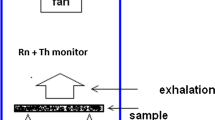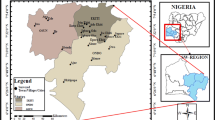Abstract
Studies have confirmed that elevated levels of radon/thoron in the human–environments can substantially increase the risk of lung cancer in general population. The building materials are the second largest contributors to indoor radon/thoron after soil and bedrock beneath dwellings. In present investigation, the exhalation rates of radon/thoron from different building materials samples have been analysed using active technique. Radon/thoron concentrations in a model room have been predicted based on the exhalation rates from walls, floor and roof. The indoor concentrations show significant variations depending upon the ventilation rate and type of building materials used.





Similar content being viewed by others
References
Abu-Jarad FA (1988) Application of nuclear track detectors for radon related measurements. Int J Radiat Appl Instrum Part D Nucl Tracks Radiat Meas 15:525–534. https://doi.org/10.1016/1359-0189(88)90195-1
Aswal S, Kandari T, Sahoo BK et al (2016) Emission of soil gas radon concentration around main Central Thrust in Ukhimath (Rudraprayag) region of Garhwal Himalaya. Radiat Prot Dosim 171:243–247. https://doi.org/10.1093/rpd/ncw067
Bourai AA, Aswal S, Kandari T et al (2016) Study of radon flux from soil in Budhakedar region using SRM. Radiat Prot Dosim 171:267–270. https://doi.org/10.1093/rpd/ncw072
Chauhan RP, Kumar A, Chauhan N et al (2014) Ventilation effect on indoor radon-thoron levels in dwellings and correlation with soil exhalation rates. Indoor Built Environ. https://doi.org/10.1177/1420326X14542887
Chen J, Rahman NM, Atiya IA (2010) Radon exhalation from building materials for decorative use. J Environ Radioact 101:317–322. https://doi.org/10.1016/j.jenvrad.2010.01.005
Darby S, Hill D, Auvinen A et al (2005) Radon in homes and risk of lung cancer: collaborative analysis of individual data from 13 European case-control studies. BMJ 330:223
ICRP (1993) Protection against radon-222 at home and at work. A report of a task group of the international commission on radiological protection. ICRP Publ 65:1–49
Krewski D, Lubin JH, Zielinski JM et al (2006) A combined analysis of North American case-control studies of residential radon and lung cancer. J Toxicol Environ Heal Part A 69:533–597
Kumar A, Chauhan RP, Joshi M, Sahoo BK (2014) Modeling of indoor radon concentration from radon exhalation rates of building materials and validation through measurements. J Environ Radioact 127:50–55. https://doi.org/10.1016/j.jenvrad.2013.10.004
Nazaroff WW, Nero AV Jr. (1988) Radon and its decay products in indoor air. Wiley, New York
Petropoulos NP, Anagnostakis MJ, Simopoulos SE (2001) Building materials radon exhalation rate: ERRICCA intercomparison exercise results. Sci Total Environ 272:109–118. https://doi.org/10.1016/S0048-9697(01)00674-X
Petropoulos NP, Anagnostakis MJ, Simopoulos SE (2002) Photon attenuation, natural radioactivity content and radon exhalation rate of building materials. J Environ Radioact 61:257–269. https://doi.org/10.1016/S0265-931X(01)00132-1
Ramola RC, Choubey VM, Negi MS et al (2008) Radon occurrence in soil-gas and groundwater around an active landslide. Radiat Meas 43:98–101. https://doi.org/10.1016/j.radmeas.2007.05.054
Ramola RC, Choubey VM, Prasad G et al (2011) Radionuclide analysis in the soil of Kumaun Himalaya, India, using gamma ray spectrometry. Curr Sci 100:906–914
Sahoo BK, Nathwani D, Eappen KP et al (2007) Estimation of radon emanation factor in Indian building materials. Radiat Meas 42:1422–1425. https://doi.org/10.1016/j.radmeas.2007.04.002
Sahoo BK, Agarwal TK, Gaware JJ, Sapra BK (2014) Thoron interference in radon exhalation rate measured by solid state nuclear track detector based can technique. J Radioanal Nucl Chem 302:1417–1420. https://doi.org/10.1007/s10967-014-3580-5
Singh P, Sahoo BK, Bajwa BS (2016) Theoretical modeling of indoor radon concentration and its validation through measurements in South-East Haryana, India. J Environ Manag 171:35–41. https://doi.org/10.1016/j.jenvman.2016.02.003
Stoulos S, Manolopoulou M, Papastefanou C (2003) Assessment of natural radiation exposure and radon exhalation from building materials in Greece. J Environ Radioact 69:225–240. https://doi.org/10.1016/S0265-931X(03)00081-X
UNSCEAR (1993) United Nation Scientific Committee on the Effects of Atomic Radiation: sources, effects and risks of ionizing radiation. New York, United Nations: Report to the General Assembly
UNSCEAR (2000) United Nation Scientific Committee on the Effects of Atomic Radiation: sources, effects and risks of ionizing radiation, vol 1. New York, United Nations: Report to the General Assembly
UNSCEAR (2008) United Nation Scientific Committee on the Effects of Atomic Radiation: sources, effects and risks of ionizing radiation. New York, United Nations: Report to the General Assembly
WHO (2009) World Health Organization, handbook on indoor radon: a public health perspective, 20 Avenue Appia, 1211 Geneva 27, Switzerland
Yadav M, Prasad M, Joshi V et al (2016) A comparative study of radium content and radon exhalation rate from soil samples using active and passive techniques. Radiat Prot Dosim 171:254–256. https://doi.org/10.1093/rpd/ncw069
Acknowledgements
The authors are grateful to Board of Research in Nuclear Science (BRNS), Department of Atomic Energy (DAE), Govt. of India [Project Ref. No.2013/36/54BRNS/2439] to carry out this work.
Author information
Authors and Affiliations
Corresponding author
Rights and permissions
About this article
Cite this article
Kumar, M., Sharma, N. & Sarin, A. Prediction of indoor radon/thoron concentration in a model room from exhalation rates of building materials for different ventilation rates. Acta Geophys. 66, 1249–1255 (2018). https://doi.org/10.1007/s11600-018-0159-5
Received:
Accepted:
Published:
Issue Date:
DOI: https://doi.org/10.1007/s11600-018-0159-5




